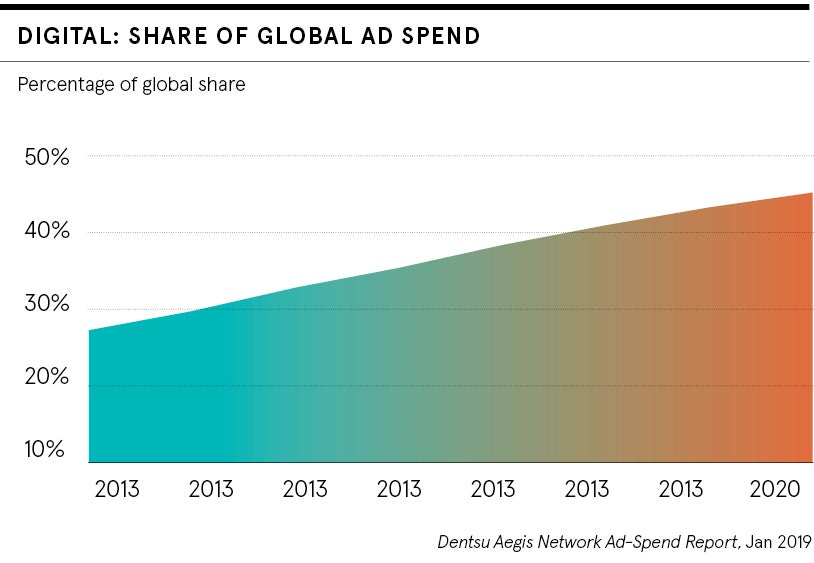At any other point in its history, a conversation about the future of advertising would be a conversation about the future of brands. The two are inextricably linked. We all have a favourite ad, but it’s brands that define our industry and endure in the public’s mind.
The paradox is that our industry’s enthusiastic adoption of all things digital has, arguably, been at the expense of its passion for brands.
Worldwide, nearly 40 per cent of advertising spend now flows to digital channels. In markets such as the UK and China it’s 60 per cent and still growing in double digits year on year. The market response has been a pivot towards short-termism. For the most part, new digital advertising dollars are focused on performance marketing and precision targeting. Where boardroom conversations about advertising might once have been about the latest campaign, they are more likely now to focus on in-housing marketing operations and onboarding technology.
But the case for strong brands endures. For established businesses, investment in their brands is vital as they face a salami-slicing of market share by digital newcomers and massive disruption of their model by tech platforms. At the other extreme, the digital economy is creating new entrants in unprecedented numbers. These businesses are using ecommerce and data to quickly build market share, but often run into a “TV moment” at the point they need to scale.
Even the global tech giants are learning that strong brands are more sustainable. Amazon outspent both Tesco and Unilever on traditional media in the UK last year, though brand investment may be as much an effort to manage regulatory attention as to woo the consumer.
All this points to a central question for the future of advertising: can digital alone build and sustain big brands? One consequence of the fixation with using digital channels to meet short-term objectives is that we don’t truly know. But if advertising’s future is to be an enduring one, we need a longer-term view. The ability to apply the key principles of brand advertising – brand fame, delivered through mass reach and simultaneity – is ultimately shrinking, though not as fast as is claimed, as mass audiences fragment and people move to on-demand viewing.
Instead of asking whether digital channels can build big brands, perhaps we need to ask a different question: is digital changing the nature of brands themselves? The evidence suggests it is.

The gold rush to gather data is slowly giving way to the more human challenge of how you interpret and apply data in ways that strengthen relationships between people and brands. In business terms this represents a people premium, where understanding your customers and acting on that data has become intrinsic to shareholder value. Through our consulting practice, we have analysed consumer centricity across more than 300 businesses and the correlation with growth is clear.
As a consequence, brands are getting smarter. They are becoming more purposeful, more focused on the utility they provide and how to create more meaningful services for what were previously simply packaged goods and physical products.
IKEA is a fantastic example. It has understood the risk to its brand of being perceived as “fast furniture” in a world buying into the circular economy. Great-looking furniture is no longer enough, we want products that can be repaired, recycled and resold; a trend underpinned by access to information and the networking digital effects. The company’s response has been to trial furniture rental, for businesses at first, but products for the home may follow, and to launch learning labs in-store and online, helping customers find new ways to think about old products.
When we use data to think this way about the role that brands play in people’s lives, the question of whether and how brands can be sustained in the digital economy answers itself: the opportunities are unlimited. Perhaps the biggest challenge as we consider the future of advertising is to think about what we advertise, rather than how.
For more information please visit www.carat.com



